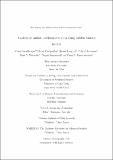Files in this item
Analysis of animal accelerometer data using hidden Markov models
Item metadata
| dc.contributor.author | Leos-Barajas, Vianey | |
| dc.contributor.author | Photopoulou, Theoni | |
| dc.contributor.author | Langrock, Roland | |
| dc.contributor.author | Patterson, Toby A. | |
| dc.contributor.author | Watanabe, Yuuki Y. | |
| dc.contributor.author | Murgatroyd, Megan | |
| dc.contributor.author | Papastamatiou, Yannis P. | |
| dc.date.accessioned | 2018-05-04T14:30:14Z | |
| dc.date.available | 2018-05-04T14:30:14Z | |
| dc.date.issued | 2017-02 | |
| dc.identifier | 252783232 | |
| dc.identifier | 57cd70b8-2bd0-4a5c-a08f-e57d4378becd | |
| dc.identifier | 000395092500003 | |
| dc.identifier | 84999663730 | |
| dc.identifier | 000395092500003 | |
| dc.identifier.citation | Leos-Barajas , V , Photopoulou , T , Langrock , R , Patterson , T A , Watanabe , Y Y , Murgatroyd , M & Papastamatiou , Y P 2017 , ' Analysis of animal accelerometer data using hidden Markov models ' , Methods in Ecology and Evolution , vol. 8 , no. 2 , pp. 161-173 . https://doi.org/10.1111/2041-210X.12657 | en |
| dc.identifier.issn | 2041-210X | |
| dc.identifier.other | ORCID: /0000-0001-9616-9940/work/44748885 | |
| dc.identifier.uri | https://hdl.handle.net/10023/13300 | |
| dc.description | Y.Y.W. was funded by Grants‐in‐Aid for Scientific Research from the Japan Society for the Promotion of Science (grant reference 25850138). T.P. was supported by a South African National Research Foundation Scarce Skills Postdoctoral Research Fellowship, and T.P. and Y.P.P. received funding from the MASTS pooling initiative (The Marine Alliance for Science and Technology for Scotland) and their support is gratefully acknowledged. MASTS is funded by the Scottish Funding Council (grant reference HR09011) and contributing institutions. T.P. and M.M. gratefully acknowledge the hardware, software, support and expertise contributed by Prof. Willem Bouten and his research group UvA‐BiTS (University of Amsterdam Bird Tracking System). | en |
| dc.description.abstract | 1. Use of accelerometers is now widespread within animal biologging as they provide a means of measuring an animal's activity in a meaningful and quantitative way where direct observation is not possible. In sequential acceleration data, there is a natural dependence between observations of behaviour, a fact that has been largely ignored in most analyses. 2. Analyses of acceleration data where serial dependence has been explicitly modelled have largely relied on hidden Markov models (HMMs). Depending on the aim of an analysis, an HMM can be used for state prediction or to make inferences about drivers of behaviour. For state prediction, a supervised learning approach can be applied. That is, an HMM is trained to classify unlabelled acceleration data into a finite set of pre-specified categories. An unsupervised learning approach can be used to infer new aspects of animal behaviour when biologically meaningful response variables are used, with the caveat that the states may not map to specific behaviours. 3. We provide the details necessary to implement and assess an HMM in both the supervised and unsupervised learning context and discuss the data requirements of each case. We outline two applications to marine and aerial systems (shark and eagle) taking the unsupervised learning approach, which is more readily applicable to animal activity measured in the field. HMMs were used to infer the effects of temporal, atmospheric and tidal inputs on animal behaviour. 4. Animal accelerometer data allow ecologists to identify important correlates and drivers of animal activity (and hence behaviour). The HMM framework is well suited to deal with the main features commonly observed in accelerometer data and can easily be extended to suit a wide range of types of animal activity data. The ability to combine direct observations of animal activity with statistical models, which account for the features of accelerometer data, offers a new way to quantify animal behaviour and energetic expenditure and to deepen our insights into individual behaviour as a constituent of populations and ecosystems. | |
| dc.format.extent | 13 | |
| dc.format.extent | 809243 | |
| dc.language.iso | eng | |
| dc.relation.ispartof | Methods in Ecology and Evolution | en |
| dc.subject | Activity recognition | en |
| dc.subject | Animal behaviour | en |
| dc.subject | Latent states | en |
| dc.subject | Serial correlation | en |
| dc.subject | Time series | en |
| dc.subject | QH301 Biology | en |
| dc.subject | DAS | en |
| dc.subject | SDG 14 - Life Below Water | en |
| dc.subject.lcc | QH301 | en |
| dc.title | Analysis of animal accelerometer data using hidden Markov models | en |
| dc.type | Journal article | en |
| dc.contributor.institution | University of St Andrews. School of Biology | en |
| dc.contributor.institution | University of St Andrews. Centre for Research into Ecological & Environmental Modelling | en |
| dc.identifier.doi | https://doi.org/10.1111/2041-210X.12657 | |
| dc.description.status | Peer reviewed | en |
This item appears in the following Collection(s)
Items in the St Andrews Research Repository are protected by copyright, with all rights reserved, unless otherwise indicated.

